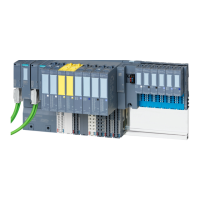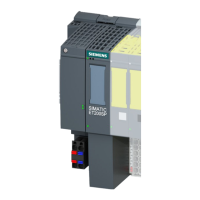Configuring
4-42 Application Module FM 458-1 DP - User Manual
A5E01078222-02 Edition 03.2009
Basic clock cycle T0
SYNC telegramT0 interrupt T0 Interrupt SYNC telegram
cycle
cycle
Interrupt task Ix
Processing time of the
SIMOLINK blocks
Processing time of the
SIMOLINK blocks
Fig. 4-19 External-mode (Mode 4)
The base sampling time T0 setting must correspond as a minimum
to the bus cycle time plus the interrupt task processing time.
If data are to be transferred to other nodes after the calculation with
minimum deadtime, then either the non-synchronous mode or the timer
mode is used.
For the non-synchronous mode (Mode 1), data is directly output after
the SIMOLINK blocks have been processed in a cyclic task Tx.
Processing time of the
SIMOLINK blocks
SIMOLINK cycle SIMOLINK cycle
Cyclic task Tx
Processing time of the
SIMOLINK blocks
Fig. 4-20 Non-synchronous-mode (Mode 1)
In the timer mode (Mode 2), data is directly output after calculation in an
interrupt task Ix which assigns the processing of the SIMOLINK blocks a
higher priority.
SIMOLINK cycle SIMOLINK cycle
Timer interrupt
Interrupt task Ix
Timer interrupt
Processing time of the
SIMOLINK blocks
Processing time of the
SIMOLINK blocks
Fig. 4-21 Timer-mode (Mode 2)
In these non-synchronous SL-master modes, which exhibit jitter, the
coupled drives cannot be operated with position synchronism if the SYNC
telegram is sent in the time intervals which depend on the actual
configuring. This allows the fastest possible data transfer between SL
master (Mode 1 or 2) and the slave (Mode 0).
The slave mode (Mode 0) is used to read and evaluate the bus data
transfer in a drive ring, for e.g. monitoring and diagnostic purposes.
Fastest data send,
non-synchronous
Reading telegrams,
synchronous

